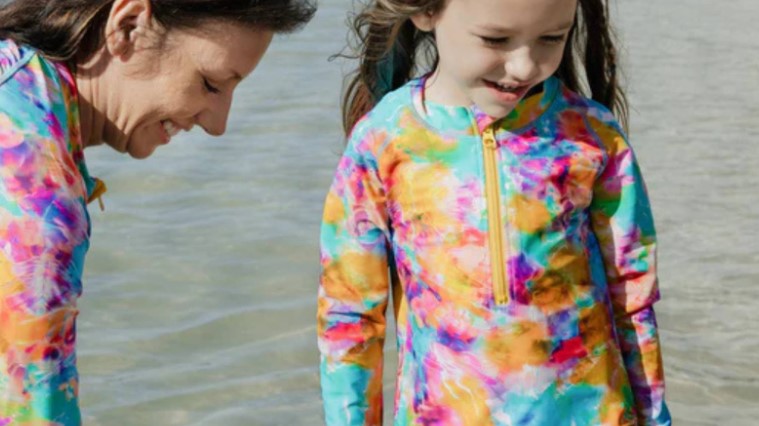
Are blue swimsuits safe?
Swimsuit color should be a part of every parent’s swim safety strategy. The colors your little ones wear affect how easy it is to see them underwater, in crowds, or at distances. Blue is a popular swimsuit color, but how safe is it?
Quick links:
Why you should care about swimsuit color
How visible are blue swimsuits underwater?
How do light and dark blue swimsuits compare?
Do water conditions affect visibility?
High visibility alternatives to dark blue swimwear
Let's explore blue swimwear safety factors and what you should know before your next water adventure.
Why you should care about swimsuit color
Swimsuit color impacts underwater visibility. Darker colors absorb light and become difficult to spot beneath the water's surface. The contrast between your swimwear and the surrounding water determines how easily others can locate you. Rescuers must quickly identify swimmers in distress, and parents must spot their children in crowded swimming areas. Every second counts during water emergencies.
Drowning remains the leading cause of accidental death for children ages 1–4, with most incidents occurring in home swimming pools where visibility can make the difference in preventing a drowning incident.
Light reflection also impacts visibility. Bright colors reflect more light waves back to the observers' eyes, while dark colors absorb light waves. This scientific principle explains why neon yellow, orange, and pink swimsuits stay visible at greater distances underwater than navy or black options.
How visible are blue swimsuits underwater?
Water naturally absorbs red light waves first, followed by orange, yellow, and green wavelengths. Blue light penetrates water most effectively, which means that the deeper you go, the more everything looks blue.
Navy and dark blue swimsuits are among the hardest colors to see underwater. These shades become nearly invisible beyond depths of 15–20 feet, especially in natural bodies of water. The limited contrast between dark blue fabric and water makes spotting swimmers difficult for lifeguards and parents.
Medium blue swimsuits offer slightly better visibility than darker options but still have significant limitations. The color similarity to water reduces contrast and detection distance. Certain weather conditions further diminish visibility; cloudy days, choppy water, or murky conditions compound these challenges.
Dark vs light blue visibility comparison
|
Factor |
Dark blue swimwear |
Light blue swimwear |
|
Visibility depth |
Visible to 10–15 feet maximum |
Visible to 20–25 feet maximum |
|
Contrast against water |
Minimal contrast |
Moderate contrast |
|
Visibility in cloudy conditions |
Nearly invisible |
Partially visible |
|
Visibility in clear water |
Poor visibility |
Fair visibility |
|
Sunlight reflection |
Absorbs most light |
Reflects some light |
|
Detection time for lifeguards |
Requires closer inspection |
Spotted somewhat faster |
|
Pool visibility |
Poor to fair visibility |
Fair to good visibility |
|
Natural water visibility |
Very poor visibility |
Reduced visibility |
SwimZip offers lighter blue swimwear with bright accent colors that stand out underwater. Our light blue designs look great, plus they keep swimmers more visible than dark blue alternatives.
How blue swimwear appears in different water conditions
Water conditions impact swimsuit visibility regardless of color. Even light blue suits become difficult to spot in some environments.
-
Pool water: Chlorinated pools with clear water provide the best visibility for blue swimwear. The controlled environment and often white or light blue pool floors create better contrast.
-
Ocean water: Salt water absorbs light differently than fresh water. Blue swimsuits blend into ocean environments, particularly in deeper areas away from shore.
-
Lake water: Natural sediment and plant material in lakes reduce underwater visibility. Blue swimwear is extremely difficult to spot, especially in deeper sections.
-
Murky water: Any water with high sediment levels, algae blooms, or stirred-up sand drastically reduces the visibility of all swimwear colors, including blue.
-
Sunlight conditions: Direct overhead sun creates better visibility than morning or evening light. Cloudy days significantly reduce underwater contrast for blue swimwear.
-
Water depth: Deep water looks dark blue, causing blue swimwear to disappear as depth increases.
-
Water movement: Choppy water, waves, or swimming pool splashing further compromise the visibility of blue swimsuits.
High visibility alternatives to dark blue swimwear
Blue is a popular swimsuit color but presents safety challenges underwater. So, if your family is concerned about water visibility, here are some alternatives you should try:
-
Neon colors (especially neon orange, green, and yellow) create maximum underwater visibility through strong contrast against water. These bright, fluorescent shades reflect more light and remain visible from greater distances than standard blue swimwear.
-
Red and pink swimwear stands out in pool environments where water clarity is high. These colors contrast with blue water and light-colored pool floors, though red loses some visibility in deeper natural water settings.
-
White swimwear with colorful accents combines traditional style with practical visibility benefits. The stark contrast between white fabric and blue water creates a visual marker that stays detectable at various depths, particularly when paired with bright accent colors.
-
Yellow maintains its visibility in both artificial and natural water environments. This versatile color works well in varied lighting conditions and water clarity levels.
SwimZip's high-visibility swimwear collection addresses safety concerns without sacrificing style and comfort. Our UPF 50+ fabric blocks harmful UV rays, and the bright colors in our neon swimsuit collection keep swimmers visible to lifeguards, parents, and other water users.
For comprehensive water safety, combine visibility-focused swimwear with constant supervision and proper swimming instruction. A swimsuit color chosen for visibility adds an important safety layer, particularly for families with young children.
Shop SwimZip Swimwear
SwimZip creates swimwear with both style and safety in mind. If you love blue, our light blue swimsuits with bright accent colors show up better underwater so you can balance safety with personal taste. All our swimwear includes UPF 50+ sun protection that blocks 98% of harmful UV rays.
Shop our sun-protective swimwear and enjoy safe, stylish selections for the whole family.
Blue swimsuit safety FAQ
What are some water safety practices for kids?
Follow these aquatic safety practices to protect children during water activities:
-
Start swimming lessons early to teach the basics of swimming.
-
Use Coast Guard-approved life jackets.
-
Keep kids safe by never leaving them unattended around water.
-
Teach children about coordination in water environments.
-
Follow every safety recommendation from lifeguards and instructors.
-
Designate a water watcher when multiple adults are present.
-
Establish and enforce pool rules consistently.
What are the safest colors for swimming?
Neon-colored swimsuits provide maximum underwater visibility. For example, bright orange creates a strong contrast against water, and neon green remains visible at greater depths. Light colors such as yellow and white also stand out well underwater.
Why do some children require closer supervision around water?
Children under five years old require closer supervision around water regardless of swimming ability or swimwear color. The majority of drownings happen quickly and silently, often when supervision lapses momentarily. Children with developmental delays or medical conditions that increase the risk of drowning need continuous, touch-distance supervision during all water activities, even when wearing high-visibility swimwear.
What defines water competency for children?
Water competency includes survival skills such as floating on back and front, treading water, swimming a short distance (typically 25 yards), and safely exiting from the water unassisted. The American Red Cross and other safety organizations recommend children master these fundamentals through structured swimming lessons. Even water-competent children need constant adult supervision, as these skills provide a foundation but don't guarantee safety in all water conditions.
How does water depth affect visibility in calm water?
In calm water, visibility changes with depth. Surface visibility may be adequate, but as depth increases, all colors darken and lose contrast. Even in seemingly clear, calm conditions, blue swimwear becomes camouflaged beyond 3-4 feet deep.
Further reading
What is the best swimsuit color to wear in the swimming pool?
What is the best swimsuit color to wear in the ocean?
What is the best swimsuit for an apple shape?



Leave a comment
This site is protected by hCaptcha and the hCaptcha Privacy Policy and Terms of Service apply.